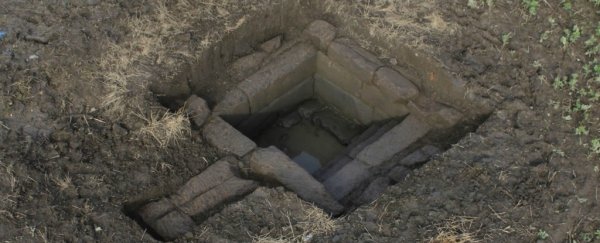Archaeologists in the UK have uncovered a small well that was traditionally used by religious pilgrims, who believed it could wash away their sins and cure various ailments such as poor eyesight.
The team thinks that the well – which is more like a shallow spring used for bathing – was built to honour Saint Anne, the supposed mother of the Virgin Mary, who had a cult following in Britain during the late Medieval Period (1066-1485 AD). And according to folklore, that well was cursed.
Researchers from the Historic England Heritage have named the religious site St. Anne's Well, and it was found buried on a piece of privately owned land near Liverpool.
Local archaeologists and the owner of the property were aware of the well for some time, but until now, no one had excavated it, and it had only been identified by photographs taken in 1983.
Now that it's original structure has been uncovered, researchers have been given new insight into when and how the well was used.
"When we first got to the well we found that there was very little indication of it on the surface, but after excavation, it was found to be in reasonable condition," the team's supervising archaeologist, Jamie Quartermaine, told Rossella Lorenzi at Seeker.
"This well was probably a late Medieval foundation as the cult of St. Anne did not become widespread in England until after the end of the 14th century."
During the time it was constructed, healing wells were all the rage in Britain, and St. Anne was commonly attributed to them – though many other healing wells were built in honour of other saints, too.
This well in particular would have seen pilgrims stepping into a pool of spring water roughly 1.2 metres (4 feet) deep, where they could wash away sins or attempt to be healed through divine powers.
The well was thought to be maintained by a priory of 12 local monks that were so successful, they even managed to turn a profit from the land, and the well grew so popular that two of the monks became full-time caretakers of it.
"The well attracted numbers of pilgrims, necessitating the building of a small three-roomed structure around the well and the custodianship of two of the monks," Quartermaine told Seeker.
The well's popularity wasn't the only thing that made it stand out – legend says it was 'cursed' sometime during the 16th century.
According to a newspaper report from 1877, the story goes that a neighbouring landowner by the name of Hugh Darcy was upset with the amount of space the well was taking up, prompting a dispute with Father Delwaney, one of the monks who helped run the monastery.
The feud reached a tipping point when the two were arguing near the well, and Darcy told the monk that he wouldn't be in business for much longer.
A few days later, a messenger from the king at the time – most likely Henry VIII, who had a thing for closing monasteries – came to close the facility and well, and an upset Father Delwaney promptly cursed Darcy and told him he would be dead in under a year.
Moments after the curse was muttered, the legend states that Delwaney fell over dead.
To be clear, this story is based on nothing more than hearsay, that has probably been exaggerated more and more with each telling.
But according to the folklore, a series of unfortunate events followed Darcy around for the next year – such as his son dying mysteriously, and his finances taking a turn for the worst.
Finally, after a night of drinking, Darcy was found at the well with his head smashed in, and no one knows how he managed to suffer such a fate.
Again, it's just a legend, but it's a good one.
The researchers suspect that religious pilgrims continued bathing in the well's waters up until the 19th century, until it was eventually abandoned and ploughed over.
Now that it's been unearthed, the team plans on adding some wood around the water to ensure that it doesn't get covered up again or damaged, and will be working with local farmers to ensure the site is maintained.
The team's work has yet to appear in a peer-reviewed journal for verification, so for now, we're taking their word for it that this is the well of St. Anne from the stories.
But hopefully, after further analysis, the researchers will share the details of their work with the public and the rest of the scientific community.
And if all goes well with the excavation, one of the most long-lasting holy wells in the UK will be revived, and fingers crossed it's curse-free.
